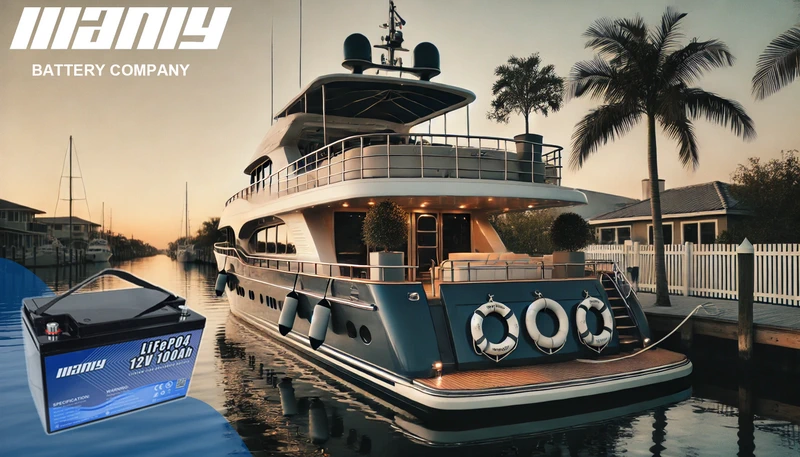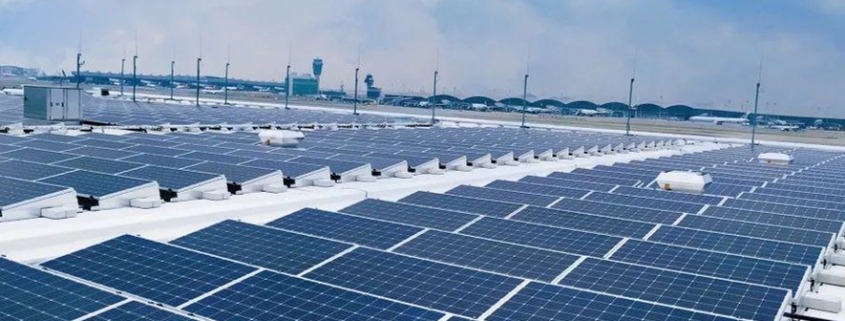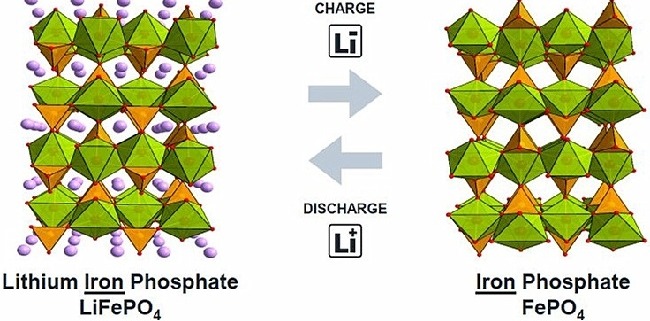What Type of Battery is a Marine Battery? A Detailed Breakdown
Table of Contents
- What Type of Battery is a Marine Battery? A Detailed Breakdown
- What is a Marine Battery?
- Different Types of Marine Batteries and Their Features
- The Best Choice: LiFePO4 Batteries for Marine Use
- Why LiFePO4 Batteries Are the Best Marine Batteries?
- Conclusion
- FAQ
- Hot Search
- Enel Green Power starts operating Texas solar and energy storage project
- The influence of low temperature on lithium iron phosphate battery
- Classification of the waterproof grade
Maintaining a consistent and dependable boating experience depends on choosing the right marine battery. Whether you use a trolling motor, start your engine, or run electronics, the appropriate battery type will make all the difference. The several choices for batteries make many sailors find it difficult to choose the right one.
This article will break apart lead-acid, AGM, gel, and LiFePO4 batteries as well as other types of marine batteries. You will learn every type in great depth, including its benefits, drawbacks, and optimal uses. By the conclusion, you will understand the reason LiFePO4 batteries are the best fit for marine applications.
What is a Marine Battery?
Designed especially to withstand adverse sea conditions, a marine battery is Unlike automobile batteries, which only provide short bursts of electricity to start an engine, marine batteries must deliver constant power for lengthy durations while tolerating vibrations, dampness, and temperature variations.
- Usually driven by its intended use, marine batteries are categorized:
- The starting battery runs the boat motor. It gives a brief, sharp boost but lacks long-term vitality.
- Deep-cycle batteries run constantly for lights, fish finders, and trolling motors among other equipment.
- A dual-purpose battery sometimes performs worse than dedicated beginning and deep cycle batteries, even if it aims to combine two uses.
These classification indicate the use of a marine battery, although the most important factor influencing battery performance is battery chemistry. Chemistry of a battery determines its general performance, longevity, efficiency, and maintenance requirements.
Different Types of Marine Batteries and Their Features
The several kinds of marine batteries are listed below, together with their characteristics:
Lead-Acid Marine Batteries
Lead-acid batteries have been used in marine conditions as they have been rather competitively priced and widely available for decades. These batteries chemically react with lead plates and sulphuric acid to generate power.
Flooded Lead-Acid (FLA) Batteries
Flooded lead-acid batteries are the most classic form. They demand consistent maintenance, including topped off distilled water. They are heavy, require ventilation, have a shorter lifetime than other battery types even if they are economically priced.
Sealed Lead-Acid Batteries
Lead-acid batteries sealed eliminate maintenance needs and are spill-proof. Two most widely used variants that improve performance over typical flooded lead-acid batteries are AGM (absorbed glass mat) batteries and gel batteries.
Advantages of Lead-Acid Marine Batteries
Lead-acid batteries are reasonably cheap and rather numerous. Their great starting current makes them worth using for engine cranking.
Disadvantages of Lead-Acid Marine Batteries
Lead-acid batteries need regular maintenance, weigh a lot, and charge slowly. Usually running for two to four years, their lifetime is short; they break down upon discharge below 50% capacity.
AGM (Absorbed Glass Mat) Marine Batteries
AGM batteries are spill-proof and maintenance-free by absorbing the electrolyte using fiberglass mats, therefore improving traditional lead-acid designs.
How do AGM Batteries Work?
By immobilising the electrolyte inside the glass mat, AGM batteries reduce the possibility of leaking and hence maximise power efficiency. Since this structure lets for better resistance to vibrations and faster charging periods, AGM batteries are a more durable replacement for flooded lead-acid batteries.
Advantages of AGM Marine Batteries
Zero maintenance and faster charging than other lead-acid models describe AGM batteries. Their lifetime is between three and six years, and they have more resistance to deep discharges.
Disadvantages of AGM Marine Batteries
AGM batteries remain heavier than lithium alternatives even with their superior performance. On a tight budget, they also appeal less to boaters since they cost more than flooded lead-acid batteries.
Gel Marine Batteries
Gel batteries use liquid electrolytes from a silica-based gel. Less leaks and greater deep discharge performance are made possible by this chemical composition.
How do Gel Batteries Work?
The gel-based electrolyte lowers chemical reactions, therefore reducing the possibility of overcharging or deep discharge. Applications needing constant, long-term power will find ideal use for these batteries.
Advantages of Gel Marine Batteries
Gel batteries resist high temperatures, maintain a longer lifetime than flooded lead-acid batteries, and require no maintenance.
Disadvantages of Gel Marine Batteries
The slow charging rate of gel batteries is its biggest drawback. Furthermore expensive than AGM and flooded lead-acid batteries are they are. Less forgiving than other battery kinds, overcharging can damage a battery permanently.
The Best Choice: LiFePO4 Batteries for Marine Use
The most intelligent and powerful marine batteries are LiFePO4 (Lithium Iron Phosphate). Unlike lead-acid batteries, which rely on chemical interactions between lead and acid, they offer constant and dependable power by means of lithium-ion technology.
Why LiFePO4 Batteries are Superior?
Among their most important benefits are LiFePO4 batteries’ extended lifespan. Lead-acid batteries run two to six years; LiFePO4 batteries can run ten years or more. Since they weigh up to 70% less than lead-acid batteries and are more easily handled, they also greatly improve boat performance.
Charging time offers still another major advantage. Five times faster charging of LiFePO4 batteries than with lead-acid batteries Unlike lead-acid batteries, which have to be kept above 50% charge, they also enable total discharges free from battery damage.
Are There Any Drawbacks to LiFePO4 Batteries?
The sole negative of LiFePO4 batteries is their starting cost. For seasoned sailors, however, they are the most affordable choice because of their long lifetime, fast charge times, and low maintenance needs.
Why LiFePO4 Batteries Are the Best Marine Batteries?
LiFePO4 batteries have long-term benefits above all other battery models, even if their initial expense makes many sailors unwilling to switch. Boats carrying LiFePO4 batteries had 30% longer running lifetime on electronic systems and trolling motors, according a study by marine engineers.
Savings in weight also improve performance. LiFePO4 technology lets a boat greatly reduce the weight of its battery, therefore enhancing fuel economy and general maneuverability. Boaters looking for dependability, fast charging, and long-lasting performance would best invest in LiFePO4 batteries.
Conclusion
The perfect sailing voyage depends on selecting the right marine battery. Though lead-acid, AGM, and gel batteries are still somewhat popular, none give the efficiency, lifetime, and long-term savings LiFePO4 batteries offer.
LiFePO4 batteries from MANLY Battery provide the finest answer if you want a dependable and high-performance marine battery. Their innovative lithium technology guarantees exceptional energy economy, therefore assuring that your boat keeps running without the trouble of regular replacements.
For premium-quality marine batteries, visit MANLY Battery today and experience the next generation of marine power solutions.
FAQ
1. Is a deep cycle battery the same as a marine battery?
Let’s clarify: a deep cycle battery and a marine battery aren’t the same, although they have similarities. Here’s why:
A deep cycle battery provides a steady power flow over an extended period. It’s designed for applications that need consistent energy, like golf carts, RVs, or renewable energy systems. These batteries are built to handle repeated discharges and recharges without losing performance.
On the other hand, a marine battery is specifically made for boats. However, marine batteries come in two types: starting and deep cycle. A starting battery delivers a quick surge of power to start the engine, while a deep cycle marine battery powers your boat’s electronics and other devices.
So, while some marine batteries are deep cycle, not all deep cycle batteries work as marine batteries. If you’re choosing a battery for your boat, ensure it’s designed for marine use to get the most reliable power.
2. What are the three types of marine batteries?
Marine batteries come in three main types, each serving a different purpose. Understanding their roles helps you pick the right one for your boat:
- Starting Batteries: Starting batteries provide a quick burst of power to start your engine. They’re all about delivering a high-energy jolt for a short time. These batteries are not designed to power other devices, so they focus only on getting your engine running.
- Deep Cycle Batteries: Need power for your boat’s electronics, trolling motor, or other accessories? Deep cycle batteries are your answer. They deliver steady, long-lasting energy and can discharge and recharge multiple times without losing capacity. Perfect for extended trips or when you’re off the grid!
- Dual Purpose Batteries: As the name suggests, dual purpose batteries combine the functions of both starting and deep cycle batteries. They give you enough power to start your engine and supply energy to your accessories. They offer versatility but may not provide as much power as a dedicated starting or deep cycle battery.
Hot Search
Marine Lithium Battery Battery Manufacturer
Hello
Enel Green Power North America has started operating two new clean power plants, including its first renewable energy and storage hybrid project. These new projects coincide with the company’s start of an accelerated growth plan, which involves adding 6.5 GW of new renewable energy capacity and 1.4 GW of energy storage capacity over the next three years.
The 181 MW Lily solar and energy storage project in eastern Dallas is the company’s first hybrid project in North America, which combines a renewable energy plant with utility-scale battery energy storage. The project includes 55 MW of DC battery energy storage, which is part of Enel’s installation of approximately 600 MW of new energy storage capacity on the Texas grid by 2022. Enel also started operating the 140 MW Rockhaven Wind Farm in Oklahoma.
Paolo Romanacci, head of Enel Green Power in the U.S. and Canada, said: “This milestone marks the beginning of a new era for our company as we begin to fulfill our main commitment to the U.S. grid-scale battery storage by combining renewable energy with storage Combining technologies, we are supporting a cleaner and more flexible grid. We are ready to respond to the calls of policymakers and business leaders to accelerate the energy transition in North America. Therefore, we are investing more than ever before to achieve The goal of accelerating growth.”
The Lily Solar and Energy Storage Project is located in the southeast of Dallas in Kaufman County, Texas, and consists of a 181 MW photovoltaic power plant and 55 MW batteries. The project’s 421,400 double-sided photovoltaic panels are expected to generate more than 367 GWh per year, which will be transmitted to the grid and charge the batteries in the same location. The battery storage system can perform power dispatch when solar power generation is low, and at the same time provide a clean power supply to the grid during periods of high demand.
The Lily solar project was initiated and developed by Red River Renewable Energy Co., Ltd., which is a joint venture between Sun Chase Power and an affiliate of MAP Energy Co., Ltd.
The Rockhaven Wind Farm in Murray County and Carter County, Oklahoma includes 49 turbines and is expected to generate 616 GWh of energy per year, enough to avoid more than 359,000 tons of carbon dioxide emissions per year. Through the first virtual power purchase agreement (PPA), Wellington’s management will purchase the 11 MW part of the project’s electricity that is transmitted to the grid. The clean energy contract signed by Wellington’s management is expected to equal or exceed the electricity demand of all its US corporate offices and the residential electricity demand of more than 2,200 employees in the United States.
Enel is currently building five other renewable energy and storage hybrid projects in Texas: Azure Sky solar and storage, Azure Sky wind and storage, Roseland solar + storage, Blue Jay solar and storage and Ranchland wind + storage projects. In addition, the company is also adding a 57-megawatt battery storage system near each power plant to the 500-megawatt high island wind farm and 497-megawatt Roadrunner solar farm in West Texas. Elsewhere in the United States, the company is building a 250 MW 25 Mile Creek wind power project in Oklahoma and a 200 MW Alta Farm wind power project in Illinois.
At present, lithium iron phosphate battery is one of the most widely used batteries on the market. This kind of battery has high safety and long cell life. However, the low temperature performance of lithium iron phosphate battery is slightly worse than that of batteries of other technical systems.
Low temperature has an impact on the positive and negative electrodes, electrolyte and binder of lithium iron phosphate. The lithium iron phosphate positive electrode itself has relatively poor electronic conductivity and is prone to polarization in low temperature environments, thereby reducing battery capacity; affected by low temperature, the speed of graphite lithium insertion is reduced, and metal lithium is likely to precipitate on the surface of the negative electrode. If it is left for insufficient time after charging, put it in When used, the metal lithium cannot be fully embedded in the graphite again, and part of the metal lithium continues to exist on the surface of the negative electrode, which is very likely to form lithium dendrites, which affects battery safety; at low temperatures, the viscosity of the electrolyte will increase, and the lithium ion migration resistance will also increase. In addition, in the production process of lithium iron phosphate, the adhesive is also a very critical factor, and low temperature will also have a greater impact on the performance of the adhesive.
Therefore, lithium iron phosphate batteries are not recommended to be used at low temperatures.
For different customers, some specific fields, such as underwater detection robots, cleaning robots, etc., have certain requirements on the waterproof level of the battery, so how is the waterproof level divided? Manly can provide waterproof lithium battery for you.
There are 9 levels of international industrial standard waterproofing, which are represented by 0-8 respectively
0: no protection
1: Water droplets will not affect the shell
2: When the shell is tilted to 15 degrees, the water droplets into the shell have no effect
3: Water or rain has no effect on the shell from the 60 degree corner
4: The liquid splashed into the shell from any direction has no harmful effect
5: Rinse with water without any harm
6: Can be used in the cabin environment
7: Can be resistant to immersion in a short time (1m)
8: Long-term immersion in water under certain pressure







